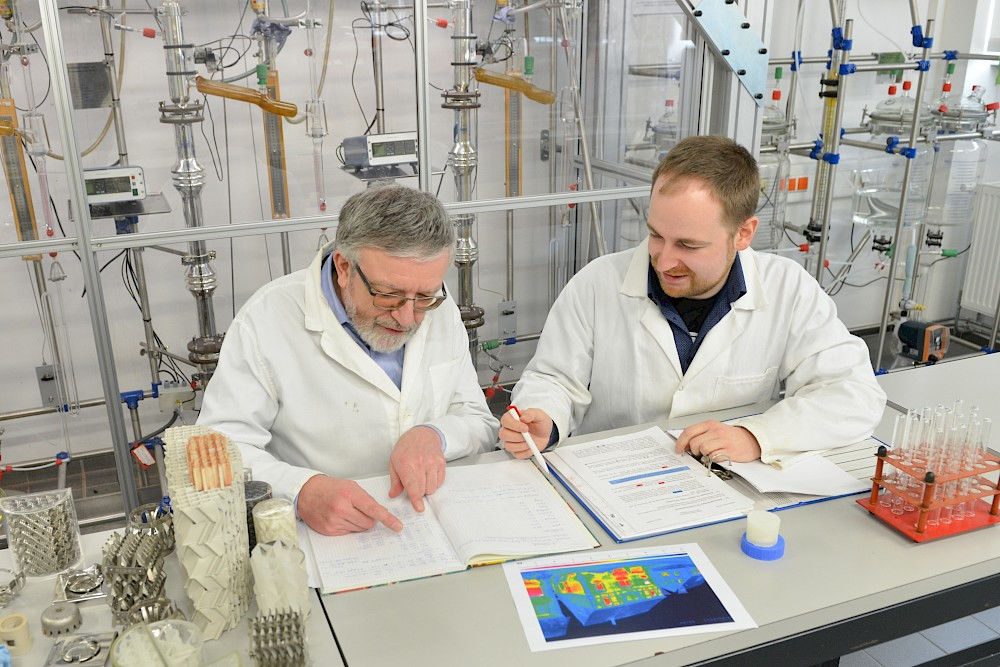Heat accumulators of the future

When Professor Thomas Hahn and his team appeared at the transHAL innovation day hosted by the university in May 2019, the second global climate strike was fresh in everyone’s minds. Just a few days before, around 1,000 young people had demonstrated in Halle for greater climate protection and a rapid withdrawal from coal-fired power – and 350,000 others had done the same throughout Germany. In their presentation entitled “Fridays for Halle’s Future – Why We Should Now Invest in Thermal Storage Materials”, the technical chemists made a deliberate reference to the climate protests launched by the Swedish activist Greta Thunberg. They presented a product that can store up to 14 times more heat than conventional building materials like concrete or plaster by changing its physical state, thus potentially helping to save energy in buildings in the future. The development managed to impress as early as December, when the chemists came in second place in the category “Most Innovative Basic Research Project” at the Hugo Junkers Awards, the largest monetary prize of its kind in the State of Saxony-Anhalt.
The relevance of this topic is clear to the researchers – according to statistics provided by the International Energy Agency, the building sector accounts for around 34 percent of the world’s energy needs, the majority of which is required for the heating and cooling of properties. “That’s obviously way too much”, says Felix Marske, a doctoral student working with Thomas Hahn. As part of his doctoral studies, the 27-year-old has spent the past two years examining latent heat storage in phase change materials (PCMs). These materials are special, because they can change from a solid to a liquid to absorb and store an enormous amount of heat, which is emitted as soon as they solidify again. These qualities are best reflected by hand-warming pads, which ensure cosy temperatures in coat pockets throughout the winter months. The storage material used here is a salt hydrate, while organic compounds like wax and fatty acids are now being used in other fields.
This form of heat storage became a talking point during the oil crisis in the 1970s, says Marske. “Phase change materials now have many industrial applications, but they’re yet to be used as frequently in the building sector”. However, they have been commercially available for a few years as a powder that is added to concrete during construction. Marske identifies one of the problems: The amount of the phase change material added to walls built in this way must remain relatively low, because their mechanical stability will otherwise be particularly impaired.
The aim of the Halle-based research project is therefore to produce panels that can be used to clad walls like traditional insulation materials. Their PCM content is much greater (around 85%), so they have a much greater thermal storage capacity but remain stable. “They can be cast as panels and attached to inside walls like normal plasterboard, which would be an option during renovations”, says Thomas Hahn. Marske has calculated that a panel measuring almost four square metres in size and two centimetres in thickness would save so much energy in a 40 square metres home that the investment could pay off in just 14 months.
The latent heat storage system developed at the Institute of Chemistry practically consists of harmless fatty acids, such as those found in soaps and hand creams. In the laboratory, a silicate structure is built around tiny droplets of these fats, each measuring under a thousandth of a millimetre in size, to lock the material in its liquid state. Immense capillary forces then prevent it from escaping. “You could even hammer a nail in the wall without the material leaking”, explains Professor Hahn. The PCM melts at 21 degree, automatically storing excess heat from the environment and preventing rooms from becoming even warmer in summer. If the room temperature falls to 18 degree or lower, the material solidifies and emits heat again. Unlike conventional insulation panels, there are no problems with mould formation.
The research results from Halle have since appeared in “RSC Advances”, a journal published by the Royal Society of Chemistry. But the development is far from over. “We’re now trying to improve the material and change its synthesis”, explains Marske. The scientists also want to reproducibly simulate the production of large panels – the product is currently only available as a sample in the form of white cylinders with a diameter of just a few centimetres. They will probably patent the production process and the optimised material in the future. Interest has already been shown by the industry, even though it might not have come from the construction sector; the research team has received an enquiry from a car manufacturer that wants to use the product to manage the thermal energy generated by electric vehicle batteries.
Professor Thomas Hahn
Institute of Chemisty
Telephone: +49 345 55-25910
Mail: thomas.hahn@chemie.uni-halle.de
Felix Marske
Institute of Chemisty
Telephone: +49 345 55-25912
Mail: felix.marske@chemie.uni-halle.de
